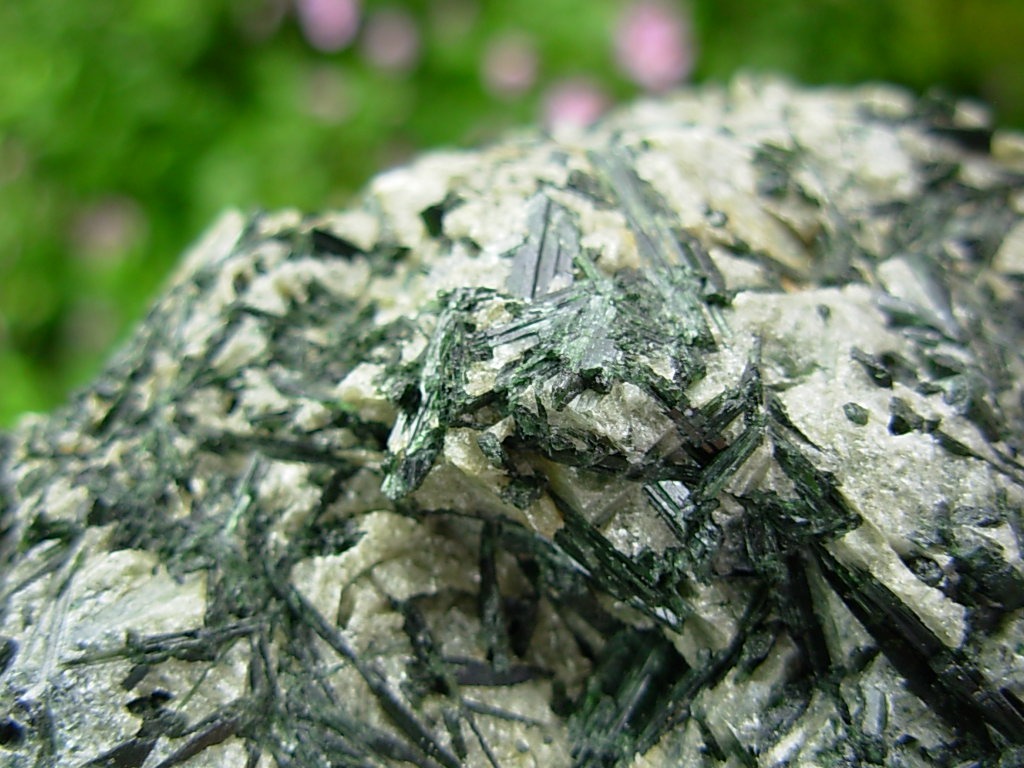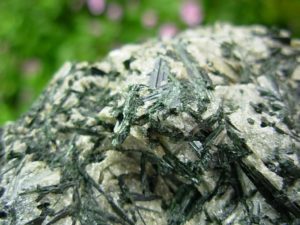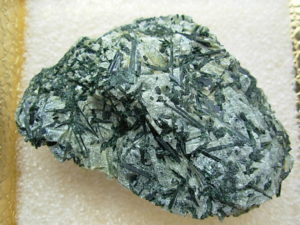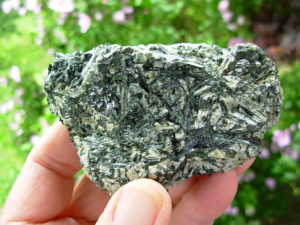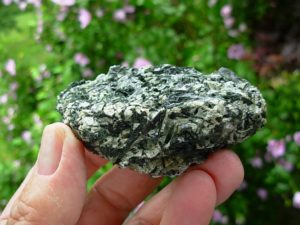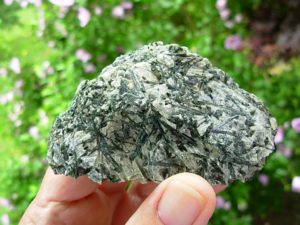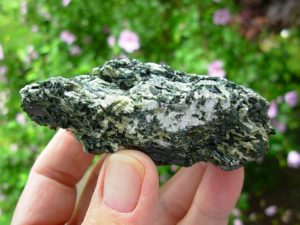Actinolite in Talc Information Page
One of our customers wanted us to locate some Actinolite in Talc from North Carolina. We were able to locate a few specimens but we had to research Actinolite and thought we would pass that information on to our customers. We found out that Actinolite is a type of Asbestos. We discovered this form is not very dangerous. The fine acicular type is the most dangerous. Please handle these specimens rarely, and always wear gloves or/and wash your hands after handling the specimens. Do not saw, sand or polish these specimens as the dust may get into your lungs.
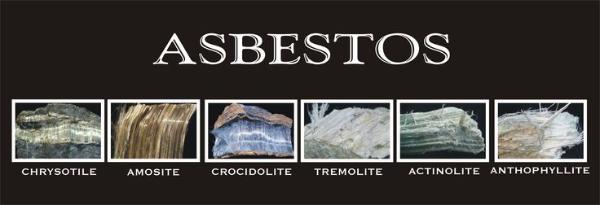
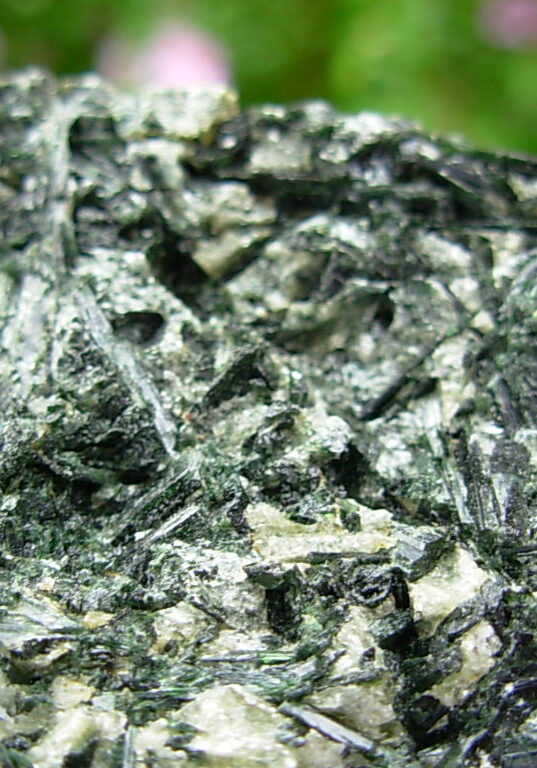
Actinolite Asbestos
Actinolite is an amphibole that is generally dark in color. Actinolite (pronounced ak-TIN-uh-lyte) can appear in multiple forms such as dense and compact or brittle and fibrous, along with different colors, including white, gray, brown or green. The mineral’s name stems from the Greek “aktinos,” meaning “ray” or “beam,” stemming from its radiating fibrous form.
Actinolite is made up of other minerals and substances such as Calcium, Magnesium, Iron, Silicon, Oxygen and Hydrogen. Actinolite is typically used with the similar mineral vermiculite, which expands when heated. Vermiculite and actinolite make for an effective, light-weight insulation material. Other common uses for actinolite and vermiculite include Insulation material, Gardening, Concrete materials used in construction and Structural fire-
proofing. Actinolite may still be present in buildings, homes or other locations that were constructed before asbestos was known to be a hazardous material. This material has been found in products such as Paints, Sealants, Drywall, Joint compounds and Children's toys
Amphiboles crystallize into two crystal systems, monoclinic and orthorhombic. Amphiboles are minerals of either igneous or metamorphic origin; in the former case occurring as constituents (hornblende) of igneous rocks, such as granite, diorite, andesite and others. Those of metamorphic origin include examples such as those developed in limestones by contact metamorphism (tremolite) and those formed by the alteration of other ferromagnesian minerals (hornblende). Pseudomorphs of amphibole after pyroxene are known as uralite.
The name amphibole (from the Greek word amphibolos meaning 'ambiguous') was used by René Just Haüy to include tremolite, actinolite, tourmaline and hornblende. The group was so named by Haüy in allusion to the protean variety, in composition and appearance, assumed by its minerals. This term has since been applied to the whole group. Four of the amphibole minerals are among the minerals commonly called asbestos. These are: Anthophyllite, Riebeckite, Cummingtonite/Grunerite series, and Actinolite/Tremolite series. The Cummingtonite/Grunerite series is often termed Amosite,or Brown Asbestos and Riebeckite is known as Crocidolite or Blue Asbestos. These are generally called Amphibole Asbestos.
Orthorhombic series
Anthophyllite, Holmquistite and Ferrogedrite
Monoclinic series
Tremolite, Actinolite, Cummingtonite, Grunerite, Hornblende, Glaucophane, Riebeckite (or Crocidolite), Arfvedsonite, Richterite, Pargasite, Winchite and Edenite.
Due to the wide variations in chemical composition, the different members vary considerably in properties and general appearance. Anthophyllite occurs as brownish, fibrous or lamellar masses with hornblende in mica-schist at Kongsberg in Norway and some other localities. An aluminous related species is known as gedrite and a deep green Russian variety containing little iron as kupfferite. Hornblende is an important constituent of many igneous rocks. It is also an important constituent of amphibolites formed by metamorphism of basalt.
Actinolite is an important and common member of the monoclinic series, forming radiating groups or acicular crystals of a bright green or greyish-green color. It occurs frequently as a constituent of green schists. The name (from Greek a 'ray' and a 'stone') is a translation of the old German word Strahlstein (radiated stone). Glaucophane, crocidolite, riebeckite and arfvedsonite form a somewhat special group of alkali-amphiboles. The first two are blue fibrous minerals, with glaucophane occurring in blueschists and crocidolite (blue asbestos) in ironstone formations, both resulting from dynamo-metamorphic processes. The latter two are dark green minerals, which occur as original constituents of igneous rocks rich in sodium, such as nepheline-syenite and phonolite.
information paraphrased and photos courtesy of;
en.wikipedia.org/wiki/Actinolite
www.asbestos.com/asbestos/types/
www.mindat.org/min-18.html
www.minerals.net/mineral/actinolite.aspx
www.nationaldryout.com/asbestos---residential.html
If you are looking for legal assistance concerning asbestos related cancers the following agency has responded to our web page and we are including a link to them if you are looking for help...
Their website is https://www.mesotheliomalawyercenter.org/
and in addition to providing visitors with comprehensive mesothelioma cancer information, they also help asbestos victims recover money for medical treatment and other expenses.
This is an educational specimen of Actinolite in Talc from the Carolina Talc Mines (Kinsey Mine, Bailey Mine, Notla Mine) in the Murphy Marble Belt region in Cherokee County, North Carolina.
This specimen weighs 6.9 oz (197g) and measures 3.4 x 2.2 x 1.2 inches (8.8 x 5.7 x 3.1 cm)

